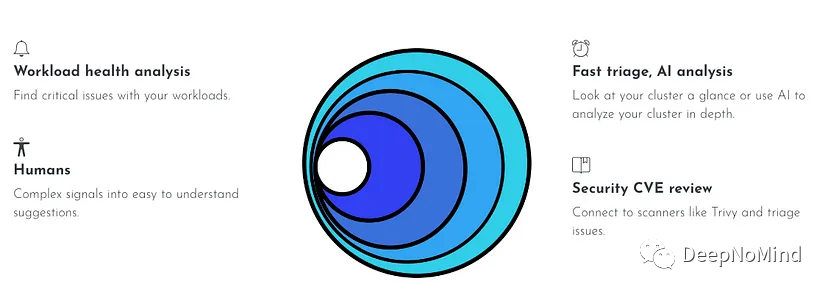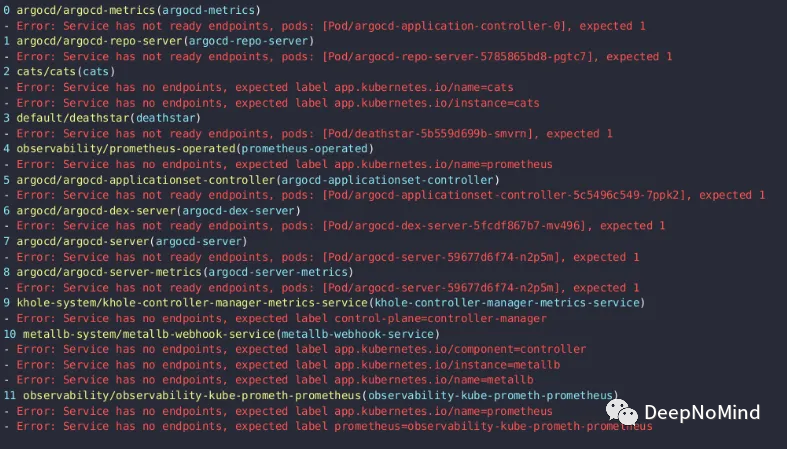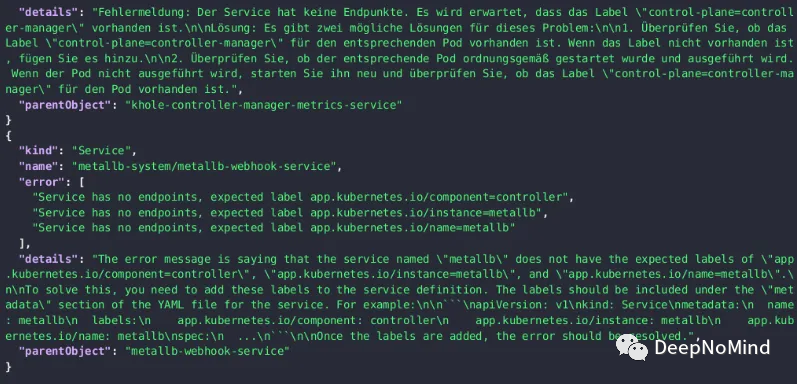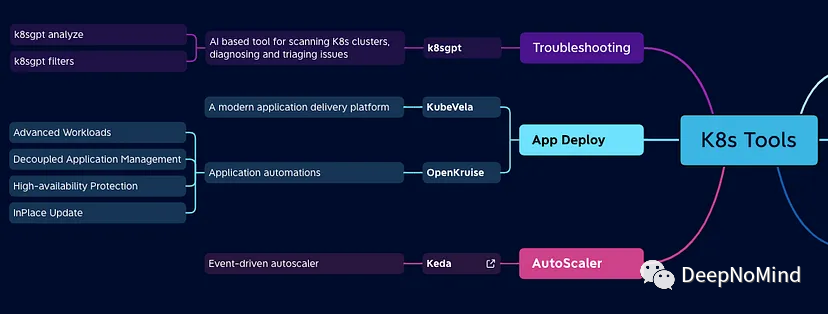The ultimate weapon for Kubernetes debugging: K8sGPT
With the continuous development of artificial intelligence and machine learning technologies, enterprises and organizations have begun to actively explore innovative strategies to use these technologies to enhance competitiveness.
K8sGPT[2] is one of the most powerful tools in this field. It is a GPT model based on k8s, which combines the advantages of k8s orchestration with the excellent natural language processing capabilities of the GPT model.

 ##According to K8sGPT Official website explanation:
##According to K8sGPT Official website explanation:
K8sgpt is a tool designed for scanning, diagnosing and classifying kubernetes cluster problems. It integrates SRE experience into its analysis engine. to provide the most relevant information. Through the application of artificial intelligence technology, K8sgpt continues to enrich its content and help users solve problems more quickly and accurately.What is K8sGPT used for?
K8sGPT has recently been submitted to the Cloud Native Computing Foundation (CNCF) as a sandbox project , demonstrating its potential value to the cloud native community.
The CNCF is currently conducting a preliminary evaluation of it, which is encouraging progress and demonstrates the dedication to creating tools that meet the needs of Kubernetes users.
 K8sGPT can be used as:
K8sGPT can be used as:
Workload health analysis: Find key issues of the workload
Quick classification, AI analysis: Inspect or drill down into clusters with AI
Assisted understanding: Transform complex signals into easy-to-understand recommendations
Security CVE review: Connect to scanners like Trivy and classify issues
How does K8sGPT work?
K8sGPT uses a set of analyzers specifically designed to detect and simplify the task of diagnosing and resolving issues in a Kubernetes cluster. Based on SRE's intelligent experience coding, these analyzers excel at providing highly accurate and relevant information.
Here are some of the built-in analyzers:
PodAnalyzer: This tool scrutinizes pod settings, searching for potential issues that could cause complex problems, such as pod failure or overcommitment of resources.- PVCAnalyzer: This tool examines the configuration of a Persistent Volume Claim (PVC), searching for any differences that could lead to data loss or other storage-related challenges.
- ServiceAnalyzer: This tool probes service settings, looking for any potential issues that may cause service interruption or performance degradation.
- DeploymentAnalyzer: This tool examines the Deployment configuration to identify any issues that may lead to inefficient resource utilization.
- NodeAnalyzer: This tool examines K8s cluster nodes and identifies any potential issues related to node health, usage, and capacity.
- How to install K8sGPT?
(1) Prerequisites:
Make sure k8sgpt is installed correctly- Ready-made K8s cluster
- OpenAI provides the API key as the default AI provider
- Homebrew:
Install K8sGPT using the following command:
$ brew install k8sgpt
$ curl -LO https://github.com/k8sgpt-ai/k8sgpt/releases/download/v0.2.7/k8sgpt_amd64.rpm$ sudo rpm -ivh -i k8sgpt_amd64.rpmPreparing...################################# [100%]Updating / installing... 1:k8sgpt-0:0.2.7-1 ################################# [100%]
$ curl -LO https://github.com/k8sgpt-ai/k8sgpt/releases/download/v0.2.7/k8sgpt_amd64.deb$ sudo dpkg -i k8sgpt_amd64.deb
$ curl -LO https://github.com/k8sgpt-ai/k8sgpt/releases/download/v0.2.7/k8sgpt_amd64.apk$ apk add k8sgpt_amd64.apk
$ k8sgpt versionk8sgpt version 0.2.7
Note: It is assumed that you already have OpenAI API-key
$ k8sgpt authUsing openai as backend AI providerEnter openai Key: New provider addedkey added
Once you complete OpenAI authentication, you can start using K8sGPT by entering the following command:
$ k8sgptKubernetes debugging powered by AIUsage:k8sgpt [command]Available Commands:analyze This command will find problems within your Kubernetes clusterauthAuthenticate with your chosen backendcompletionGenerate the autocompletion script for the specified shellfilters Manage filters for analyzing Kubernetes resourcesgenerateGenerate Key for your chosen backend (opens browser)helpHelp about any commandintegration Intergrate another tool into K8sGPTserve Runs k8sgpt as a serverversion Print the version number of k8sgptFlags:--config stringconfig file (default is $HOME/.k8sgpt.yaml)-h, --help help for k8sgpt--kubeconfig stringPath to a kubeconfig. Only required if out-of-cluster. (default "/mnt/efs/data/home/txu/.kube/config")--kubecontext string Kubernetes context to use. Only required if out-of-cluster.Use "k8sgpt [command] --help" for more information about a command.
$ k8sgpt analyze --explain
 You can also output JSON format:
You can also output JSON format:
 View available filters Filter:
View available filters Filter:
$ k8sgpt filters listActive:> Service> CronJob> Node> Pod> Deployment> Ingress> StatefulSet> ReplicaSet> PersistentVolumeClaimUnused:> HorizontalPodAutoScaler> PodDisruptionBudget> NetworkPolicy
filters:
$ k8sgpt analyze --filter=Service $ k8sgpt analyze --namespace=default
$k8sgpt analyze --anonymize
$k8sgpt auth -b
## As businesses and organizations continue to explore creative ways to leverage AI and With the power of machine learning, K8sGPT is becoming a powerful tool to help them achieve their goals. Leveraging superior natural language processing capabilities and K8s orchestration advantages, K8sGPT has the potential to revolutionize the way we analyze and understand text data, thereby promoting innovation in many fields. 
Reference materials:
[1]K8s Tools — K8sGPT: https://blog.devgenius.io/k8s-tools-k8sgpt-1fd35e6affc
- [2]K8sGPT: https://docs.k8sgpt.ai
The above is the detailed content of The ultimate weapon for Kubernetes debugging: K8sGPT. For more information, please follow other related articles on the PHP Chinese website!

Hot AI Tools

Undresser.AI Undress
AI-powered app for creating realistic nude photos

AI Clothes Remover
Online AI tool for removing clothes from photos.

Undress AI Tool
Undress images for free

Clothoff.io
AI clothes remover

AI Hentai Generator
Generate AI Hentai for free.

Hot Article

Hot Tools

Notepad++7.3.1
Easy-to-use and free code editor

SublimeText3 Chinese version
Chinese version, very easy to use

Zend Studio 13.0.1
Powerful PHP integrated development environment

Dreamweaver CS6
Visual web development tools

SublimeText3 Mac version
God-level code editing software (SublimeText3)

Hot Topics
 What are the types of return values of c language function? Summary of types of return values of c language function?
Apr 03, 2025 pm 11:18 PM
What are the types of return values of c language function? Summary of types of return values of c language function?
Apr 03, 2025 pm 11:18 PM
The return value types of C language function include int, float, double, char, void and pointer types. int is used to return integers, float and double are used to return floats, and char returns characters. void means that the function does not return any value. The pointer type returns the memory address, be careful to avoid memory leakage.结构体或联合体可返回多个相关数据。
 How to use C language function pointer to find the maximum value of a one-dimensional array
Apr 03, 2025 pm 11:45 PM
How to use C language function pointer to find the maximum value of a one-dimensional array
Apr 03, 2025 pm 11:45 PM
Flexible application of function pointers: use comparison functions to find the maximum value of an array. First, define the comparison function type CompareFunc, and then write the comparison function compareMax(a, b). The findMax function accepts array, array size, and comparison function parameters, and uses the comparison function to loop to compare array elements to find the maximum value. This method has strong code reusability, reflects the idea of higher-order programming, and is conducive to solving more complex problems.
 How to output a countdown in C language
Apr 04, 2025 am 08:54 AM
How to output a countdown in C language
Apr 04, 2025 am 08:54 AM
How to output a countdown in C? Answer: Use loop statements. Steps: 1. Define the variable n and store the countdown number to output; 2. Use the while loop to continuously print n until n is less than 1; 3. In the loop body, print out the value of n; 4. At the end of the loop, subtract n by 1 to output the next smaller reciprocal.
 What are the pointer parameters in the parentheses of the C language function?
Apr 03, 2025 pm 11:48 PM
What are the pointer parameters in the parentheses of the C language function?
Apr 03, 2025 pm 11:48 PM
The pointer parameters of C language function directly operate the memory area passed by the caller, including pointers to integers, strings, or structures. When using pointer parameters, you need to be careful to modify the memory pointed to by the pointer to avoid errors or memory problems. For double pointers to strings, modifying the pointer itself will lead to pointing to new strings, and memory management needs to be paid attention to. When handling pointer parameters to structures or arrays, you need to carefully check the pointer type and boundaries to avoid out-of-bounds access.
 CS-Week 3
Apr 04, 2025 am 06:06 AM
CS-Week 3
Apr 04, 2025 am 06:06 AM
Algorithms are the set of instructions to solve problems, and their execution speed and memory usage vary. In programming, many algorithms are based on data search and sorting. This article will introduce several data retrieval and sorting algorithms. Linear search assumes that there is an array [20,500,10,5,100,1,50] and needs to find the number 50. The linear search algorithm checks each element in the array one by one until the target value is found or the complete array is traversed. The algorithm flowchart is as follows: The pseudo-code for linear search is as follows: Check each element: If the target value is found: Return true Return false C language implementation: #include#includeintmain(void){i
 What are c language function pointers and pointer functions? What's the difference?
Apr 03, 2025 pm 11:54 PM
What are c language function pointers and pointer functions? What's the difference?
Apr 03, 2025 pm 11:54 PM
A function pointer is a pointer to a function, and a pointer function is a function that returns a pointer. Function pointers point to functions, used to select and execute different functions; pointer functions return pointers to variables, arrays or other functions; when using function pointers, pay attention to parameter matching and checking pointer null values; when using pointer functions, pay attention to memory management and free dynamically allocated memory; understand the differences and characteristics of the two to avoid confusion and errors.
 Integers in C: a little history
Apr 04, 2025 am 06:09 AM
Integers in C: a little history
Apr 04, 2025 am 06:09 AM
Integers are the most basic data type in programming and can be regarded as the cornerstone of programming. The job of a programmer is to give these numbers meanings. No matter how complex the software is, it ultimately comes down to integer operations, because the processor only understands integers. To represent negative numbers, we introduced two's complement; to represent decimal numbers, we created scientific notation, so there are floating-point numbers. But in the final analysis, everything is still inseparable from 0 and 1. A brief history of integers In C, int is almost the default type. Although the compiler may issue a warning, in many cases you can still write code like this: main(void){return0;} From a technical point of view, this is equivalent to the following code: intmain(void){return0;}
 What does the c language function return pointer output?
Apr 03, 2025 pm 11:36 PM
What does the c language function return pointer output?
Apr 03, 2025 pm 11:36 PM
The C language function returns a pointer to output a memory address. The pointing content depends on the operation inside the function, which may point to local variables (be careful, memory has been released after the function ends), dynamically allocated memory (must be allocated with malloc and free), or global variables.






